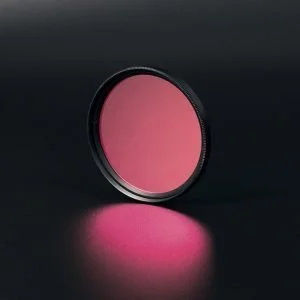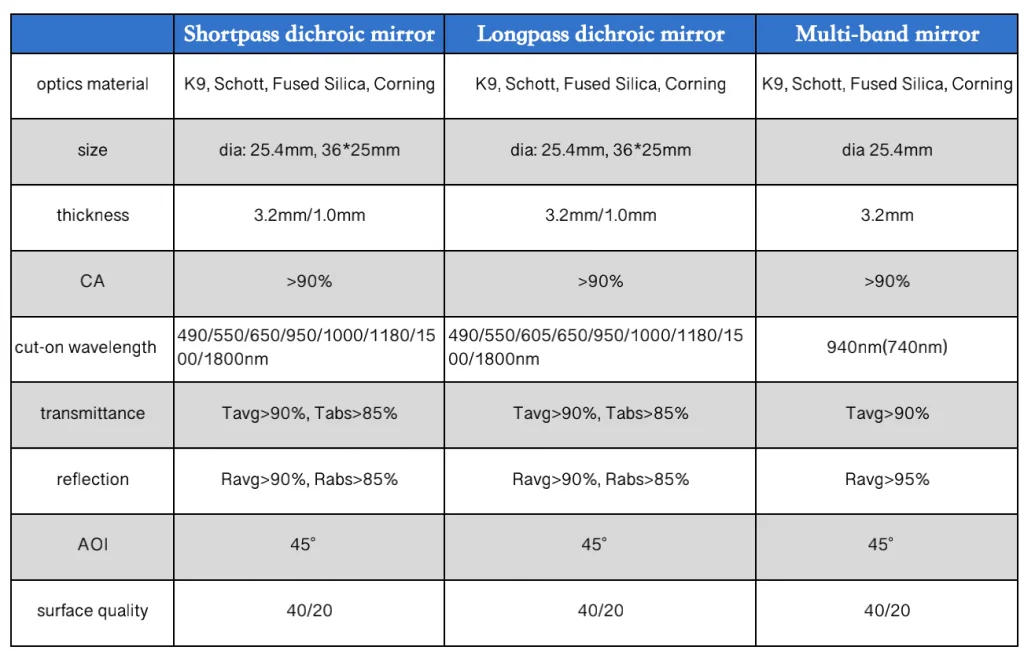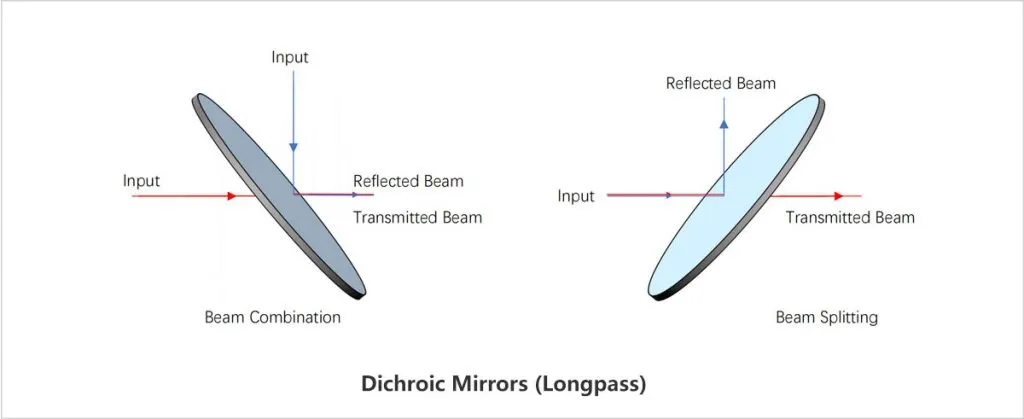Introduction
Welcome to our comprehensive guide on dichroic mirrors. In this article, we will explore the world of dichroic mirrors, their applications, manufacturing processes, and their importance in optical engineering. Whether you are a researcher, engineer, or simply curious about the fascinating world of optics, this guide will provide you with an in-depth understanding of dichroic mirrors.
Dichroic mirrors are advanced optical components that selectively reflect or transmit light based on its wavelength. They play a crucial role in various industries, including laser technology, microscopy, spectroscopy, and lighting. Understanding the principles behind dichroic mirrors and their applications is essential for anyone working with optics.

What is a Dichroic Mirror?
A dichroic mirror is an optical device that exhibits different reflectance or transmittance properties for different wavelengths of light. It consists of a thin film coating deposited onto a glass or substrate material. The unique properties of dichroic mirrors arise from the interference effects of light interacting with the multiple layers of the coating.
Dichroic mirrors are designed to selectively reflect certain wavelengths of light while transmitting others. This selective property is achieved by precisely controlling the thickness and composition of the coating layers. As a result, dichroic mirrors can be engineered to reflect specific wavelengths, making them highly versatile in a wide range of applications.
Dichroic mirrors are commonly used in optical systems to separate or combine different wavelengths of light. They are particularly useful in situations where precise control of light is required, such as in laser systems, fluorescence microscopy, and spectroscopy.

Types of Dichroic Mirrors
Dichroic mirrors come in various types, each with its unique characteristics and applications. Some of the most common types include:
Longpass Dichroic Mirrors: These mirrors transmit longer wavelengths while reflecting shorter wavelengths. They are used in applications where filtering out shorter wavelengths is necessary, such as in color separation and fluorescence microscopy.
Shortpass Dichroic Mirrors: In contrast to longpass mirrors, shortpass mirrors transmit shorter wavelengths and reflect longer wavelengths. They are commonly utilized in applications where filtering out longer wavelengths is required, such as in Raman spectroscopy and laser beam combining.
Multi-Band Dichroic Mirrors: These mirrors are designed to reflect or transmit multiple bands of wavelengths simultaneously. They find applications in systems that require the separation or combination of multiple wavelengths, such as in multi-color fluorescence microscopy and laser systems.
Hot and Cold Mirrors: Hot mirrors are designed to reflect infrared (IR) radiation while transmitting visible light. They are commonly used in applications where heat control is crucial, such as in LCD projectors and lighting fixtures. Cold mirrors, on the other hand, reflect visible light while transmitting IR radiation. They are used in applications where heat needs to be removed from the system, such as in optical systems and solar energy devices.
Each type of dichroic mirror has its specific spectral properties and applications. Understanding the characteristics of each type is essential for selecting the right mirror for a particular optical setup.

Manufacturing and Optical Properties
The manufacturing process of dichroic mirrors involves depositing thin film coatings onto glass or substrate materials. Two commonly used techniques for coating deposition are electron beam deposition and ion beam sputtering (IBS).
Electron Beam Deposition: In this technique, a high-energy electron beam is used to evaporate the coating material, which then condenses onto the substrate to form the thin film. This method allows for precise control of the coating thickness and composition, resulting in high-quality dichroic mirrors.
Ion Beam Sputtering (IBS): IBS involves bombarding a target material with high-energy ions, causing atoms to be ejected from the target and deposited onto the substrate. This technique offers excellent control over the film properties, resulting in low absorption, low scatter, and high durability dichroic mirrors.
The optical properties of dichroic mirrors depend on factors such as the composition and thickness of the coating layers. By carefully engineering the coating design, manufacturers can tailor dichroic mirrors to exhibit specific spectral characteristics, including high reflectivity or transmittance at desired wavelengths.
Applications of Dichroic Mirrors
Dichroic mirrors find a wide range of applications across various industries. Here are some notable applications:
Laser Technology:
Dichroic mirrors are essential components in laser systems. They are used for beam combining, splitting, and filtering. By selectively reflecting or transmitting specific laser wavelengths, dichroic mirrors enable the manipulation and control of laser beams. Laser systems in fields such as research, medicine, and manufacturing heavily rely on dichroic mirrors for efficient laser beam management.
Microscopy and Spectroscopy:
In fluorescence microscopy, dichroic mirrors play a critical role in separating excitation light from emission light. They selectively reflect the excitation wavelength towards the sample while allowing the emission wavelength to pass through. This enables precise imaging and analysis of fluorescent samples. Dichroic mirrors are also used in spectroscopy setups to separate different wavelengths of light, enabling accurate analysis of samples’ spectral characteristics.
Lighting Systems:
Dichroic mirrors are widely used in the lighting industry, particularly in stage lighting and architectural lighting applications. They allow for the efficient separation and manipulation of different colors of light, enabling the creation of vibrant and dynamic lighting effects. Dichroic mirrors are also utilized in LCD projectors to filter out unwanted wavelengths and improve color accuracy.
Optical Communication:
In optical communication systems, dichroic mirrors are used for wavelength division multiplexing (WDM). WDM allows multiple optical signals of different wavelengths to be transmitted simultaneously through a single optical fiber. Dichroic mirrors are used in WDM devices to separate and combine the different wavelength channels, enabling high-capacity and efficient data transmission.
Dichroic Mirrors in Optical Engineering
Dichroic mirrors play a crucial role in optical engineering, enhancing the performance and functionality of optical systems. Here are some key areas where dichroic mirrors find applications in optical engineering:
Monochromators:
Dichroic mirrors are integral components in monochromators, which are devices used to separate light into its component wavelengths. In monochromator-based plate readers, dichroic mirrors are used to direct specific wavelengths to the detectors for analysis. The precise control of light achieved by dichroic mirrors ensures accurate and reliable results in various biological and chemical assays.
Filter-Based Plate Readers:
Filter-based plate readers utilize dichroic mirrors to separate excitation light from emission light in fluorescence-based assays. The dichroic mirror reflects the excitation wavelength towards the sample while allowing the emitted fluorescence to pass through to the detector. This separation enables efficient detection and quantification of fluorescence signals.
Optical Microscopes:
Dichroic mirrors are essential components in fluorescence microscopy setups. They separate the excitation light from the emission light, enabling specific wavelengths to be directed to the sample and the detector, respectively. This selective separation allows for precise imaging and analysis of fluorescent samples, facilitating advancements in biological and biomedical research.
Optical Filters:
Dichroic mirrors are often used in conjunction with other optical filters to achieve specific spectral filtering requirements. By combining dichroic mirrors with bandpass or notch filters, engineers can create custom filter sets that precisely control the wavelengths of light transmitted or reflected. This flexibility is crucial in various applications, such as color separation, fluorescence imaging, and spectral analysis.
Selection Guide for Dichroic Filters
Choosing the right dichroic filters for a specific application is crucial to achieve optimal performance. Several factors need to be considered when selecting dichroic filters:
Wavelength Range: Determine the desired wavelength range for reflection or transmission based on the application’s requirements.
Laser Damage Threshold: Consider the power and intensity of the light source to ensure that the dichroic filters can withstand the laser power without damage.
Angle of Incidence: Take into account the desired angle of light incidence to ensure proper performance and minimize potential optical aberrations.
Back Side Anti-Reflection Coating: In applications that require maximum transmission, a back side anti-reflection coating can be beneficial to reduce unwanted reflections.
Considering these factors and consulting with optical experts can help in selecting the appropriate dichroic filters for specific applications.

Heat Control and UV Purification
Heat control and UV purification are vital considerations in various optical systems. Dichroic mirrors offer solutions in these areas:
Heat Control:
Hot Mirrors: Hot mirrors are designed to reflect infrared (IR) radiation while transmitting visible light. They are commonly used in applications where heat control is crucial, such as in LCD projectors and lighting fixtures. By reflecting IR radiation away from the system, hot mirrors help to reduce heat buildup and prevent damage to sensitive components.
Cold Mirrors: Cold mirrors, on the other hand, reflect visible light while transmitting IR radiation. They are used in applications where heat needs to be removed from the system, such as in optical systems and solar energy devices. Cold mirrors help to redirect unwanted heat without affecting the desired visible light transmission.
UV Purification:
Mercury-SC 254 nm Shortpass Filters: Dichroic mirrors can be used in UV water purification systems to filter out harmful UV-C radiation emitted by mercury lamps. Shortpass filters that transmit UV light while reflecting visible and infrared light are commonly employed. These filters ensure effective water disinfection while protecting against UV exposure.
Future Trends and Innovations
The field of dichroic mirrors is continuously evolving, with new trends and innovations shaping the future. Some of the emerging trends include:
Improved Laser Line Optics: Ongoing research and development efforts aim to enhance the performance and efficiency of laser line optics. Advances in coating technologies and manufacturing techniques are expected to result in higher reflectivity and transmission, lower losses, and improved durability.
Epitaxial Techniques: Epitaxial techniques, such as metal-organic chemical vapor deposition (MOCVD) and molecular beam epitaxy (MBE), are being explored for the growth of dichroic coatings. These techniques offer precise control over film thickness and composition, enabling the production of high-quality dichroic mirrors with enhanced performance.
Trichroic Mirrors: Trichroic mirrors, capable of reflecting or transmitting three distinct wavelength bands, are gaining attention in applications requiring complex spectral separation. Advances in coating design and manufacturing techniques are paving the way for the development of trichroic mirrors with improved spectral performance.
Stay tuned for further advancements and innovations in the field of dichroic mirrors, as researchers and engineers continue to push the boundaries of optical technology.
Conclusion
In conclusion, dichroic mirrors are versatile optical components with a wide range of applications in various industries. Their selective reflectance and transmittance properties make them invaluable tools in laser systems, microscopy, spectroscopy, and lighting. Understanding the principles behind dichroic mirrors, their manufacturing processes, and their applications is crucial for optimizing their performance in optical setups.
We hope this comprehensive guide has provided you with a deep understanding of dichroic mirrors, their selection, and their wide range of uses. By harnessing the power of dichroic mirrors in your optical systems, you can unlock new possibilities and achieve exceptional results.
Remember to consult with optical experts and manufacturers to ensure you select the appropriate dichroic filters for your specific applications. Stay updated on the latest trends and advancements in the field, as the world of dichroic mirrors continues to evolve and offer new opportunities in optical engineering.

